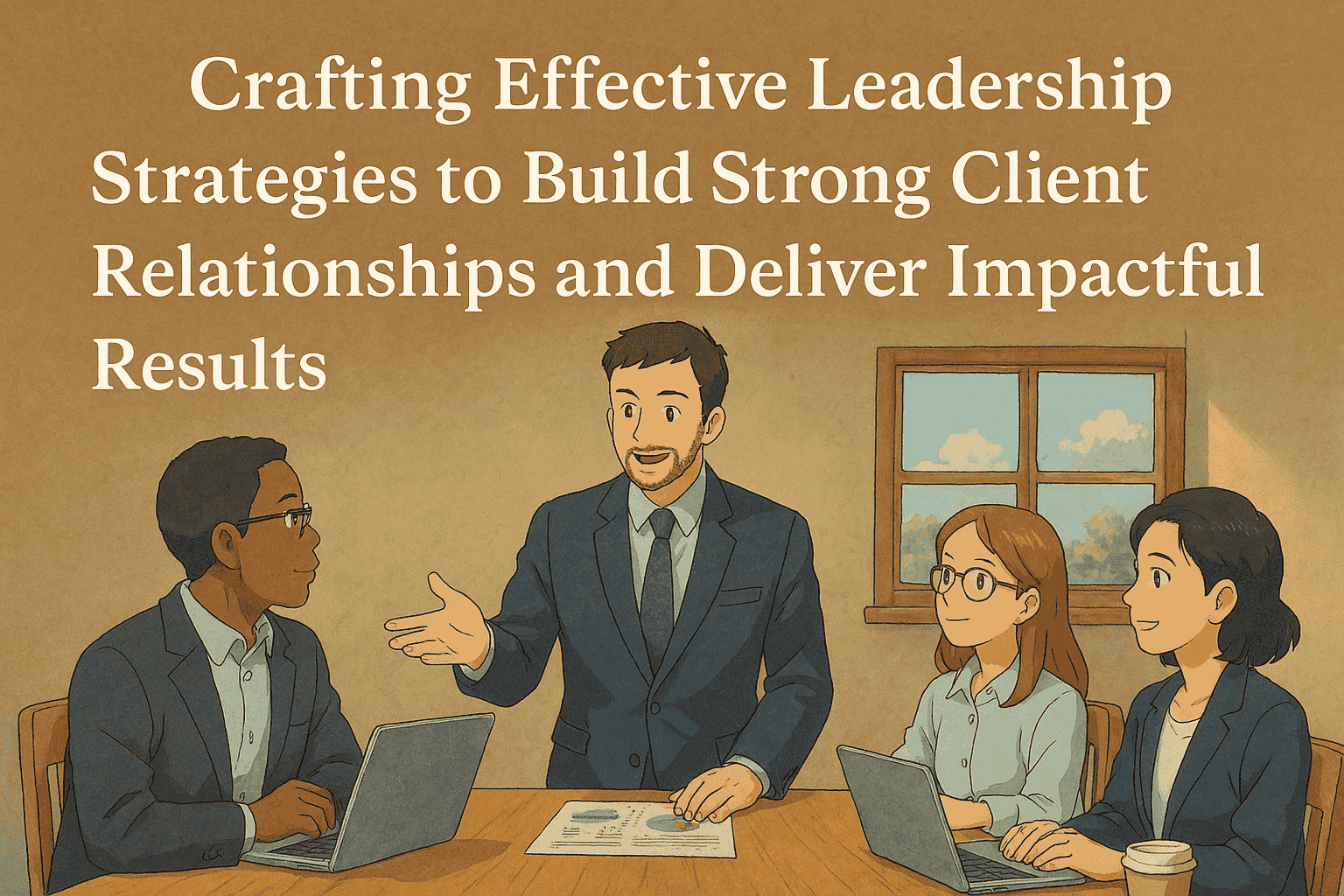Crafting Effective Leadership Strategies to Build Strong Client Relationships and Deliver Impactful Results
In today’s hyper-competitive business environment, the ability to cultivate robust client relationships and deliver impactful results is no longer optional—it’s essential. Exceptional leadership plays a pivotal role in achieving these outcomes. Strong leaders inspire trust, drive collaboration, and ensure that client needs are met with excellence and consistency.
This article explores actionable leadership strategies for building enduring client relationships while achieving measurable and sustainable success.
1. Understand the Core Needs of Your Clients
Effective leadership begins with empathy and insight. Before proposing solutions or outlining strategies, leaders must invest time in understanding the client’s core needs, goals, and pain points.
Tactics:
-
Conduct discovery meetings: Use these sessions to understand short-term and long-term goals.
-
Ask insightful questions: Go beyond the surface to uncover hidden challenges.
-
Perform stakeholder analysis: Identify key decision-makers and their expectations.
“Clients don’t care how much you know until they know how much you care.”
2. Communicate Transparently and Frequently
Transparent communication builds trust. Clients want to feel informed and included at every stage of the process. Clear, honest updates, even when delivering unfavorable news, enhance credibility and deepen relationships.
Best Practices:
-
Set regular check-ins: Weekly or biweekly touchpoints keep everyone aligned.
-
Use visual reporting tools: Dashboards and visual data simplify complex updates.
-
Be upfront about risks: Address concerns early to build confidence and avoid surprises.
3. Build a Client-Centric Culture Within Your Team
A leader’s influence on their team’s mindset can either elevate or undermine client satisfaction. Leaders must cultivate a service-oriented culture where each team member understands their role in contributing to the client’s success.
Implementation Tips:
-
Lead by example: Demonstrate client-first behavior in meetings and communication.
-
Reward client advocacy: Recognize employees who go the extra mile for clients.
-
Align KPIs with client outcomes: Ensure team goals are directly tied to client satisfaction.
4. Leverage Emotional Intelligence (EQ)
Emotional intelligence allows leaders to manage their own emotions and respond effectively to the emotions of others. High-EQ leaders build trust more quickly, resolve conflicts efficiently, and foster lasting client loyalty.
Key Components:
-
Self-awareness: Understand your strengths and triggers.
-
Empathy: Put yourself in the client’s shoes.
-
Relationship management: Navigate tensions and maintain positivity under pressure.
5. Deliver Consistent, Measurable Results
Nothing cements a client relationship like consistent performance. Great leaders develop systems and teams that are not only productive but reliable over time.
Strategy Suggestions:
-
Set SMART goals: Specific, Measurable, Achievable, Relevant, and Time-bound.
-
Establish delivery frameworks: Use proven project management methodologies like Agile or Lean.
-
Track KPIs: Use analytics to measure results and make informed adjustments.
6. Co-Create Solutions with Your Clients
Collaboration transforms clients from passive recipients to active partners. Leaders who encourage co-creation strengthen buy-in, increase innovation, and foster mutual respect.
How to Co-Create:
-
Invite client feedback: During planning, development, and delivery stages.
-
Run joint workshops: Encourage brainstorming and shared problem-solving.
-
Include clients in test phases: Their input adds valuable real-world perspective.
7. Resolve Conflicts with Poise and Purpose
Every relationship faces friction. What separates great leaders is their ability to turn conflict into opportunity. Leaders must remain calm, listen actively, and work toward solutions that prioritize the client’s long-term trust.
Conflict Resolution Framework:
-
Acknowledge the issue.
-
Listen without interrupting.
-
Propose solutions, not excuses.
-
Follow up post-resolution to ensure satisfaction.
8. Continuously Innovate and Improve
Leadership that delivers impact isn’t static. It evolves. Clients expect forward-thinking partners who bring fresh ideas, anticipate trends, and adapt strategies accordingly.
Innovation Strategies:
-
Conduct regular strategy reviews: Are your current solutions still effective?
-
Invest in learning: Stay ahead in your industry through courses and networking.
-
Encourage team innovation: Allow space for experimentation and creativity.
9. Be Proactive, Not Reactive
Strong leaders anticipate challenges before they arise. Being proactive means identifying future needs and presenting solutions before the client even realizes there’s a problem.
Proactive Habits:
-
Monitor industry trends: Bring new opportunities to clients first.
-
Perform risk assessments: Address vulnerabilities early.
-
Plan scalability: Offer growth-oriented solutions even in early stages.
10. Endorse a Long-Term Relationship Mindset
Transactional thinking limits growth. Long-term relationships are built on consistency, shared value, and mutual success. Effective leadership promotes lifetime partnerships—not just short-term wins.
Relationship-Building Tactics:
-
Celebrate milestones: Acknowledge anniversaries and project successes.
-
Provide added value: Offer exclusive insights, benchmarking reports, or complimentary consultations.
-
Solicit feedback: Show you care about their evolving needs and satisfaction.
Conclusion: Lead with Purpose, Deliver with Precision
Crafting effective leadership strategies that build strong client relationships and deliver impactful results is not a one-time event—it’s an ongoing process that requires vision, empathy, communication, and execution. When leaders commit to client-centric practices, the results ripple throughout the organization, leading to stronger partnerships, higher retention, and continuous growth.
Whether you're managing a team of five or five hundred, remember this: Great leaders don’t just manage projects—they champion client success.









